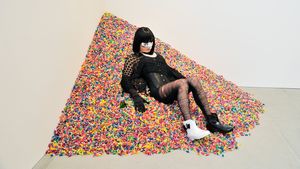Whenever I tell people I generally don't like cheese, I receive one of three reactions: pure, utter horror and dismay, pity, or odd admiration. The admiration is really more about people who love cheese but hate what it does to their intestines; they sound like their self-discipline to avoid cheeses are similar to someone who hasn't touched heroin in three years.
But when I told friends and co-workers that I was headed to France, the first thing I heard from many was that the trip was being wasted on me because I was not a fan of cheese. (Uh, hello? Wine! Come on, people, cheese is not the culinary end-all). As my poor mother knows, I’ve been averse to a majority of cheeses since childhood. Now, as a grown lady, I attempt to stomach samples at friends' parties and at Trader Joes when forced by my cheese-loving spouse. But I did resolve that while was in France, I would cautiously attempt to do as the French do: indulge in the local fromage.
I feel like I cheated a bit with my first indulgence, which was at Benoit, Alain Ducasse's Parisian institution known for its exquisite traditional cuisine. The place is exactly what you think of, when you picture a Parisian restaurant: white tablecloths, brass accents everywhere, and waiters in tuxedos. My first cheesy item in all of France was a gougeres, a delicious puff pastry with mild, melted gruyère in the middle, which Ducasse has become known for. Apparently, it’s his take on a beloved local appetizer, that most people who entertain guests around here know how to whip up quickly. Fortunately, I didn't die after eating it. Maybe because I was so damn excited that I was in Paris, I ate two of them.
The next day, we set out for the French Alps by train. We arrived at Paris's Gare du Lyon station, to the right was a grand staircase up to Train de Bleu, a traditional French restaurant that has served the fanciest of commuters since 1901. Stepping into this restaurant was like stepping into another time, when women needed hat boxes and railroad travel required steam or coal.
After a très traditionnel lunch of gelée de crevettes grises, paleron de bœuf braisé façon bourgeoise, and baba au rhum (basically a bucket of rum with some sponge cake in it) someone offered me a sampling from their desert — a cheese plate. For the record, I am baffled that people eat cheese as dessert, but hey, it takes all kinds. I was most fearful of the softer cheeses on the plate, which I am sure came from some goat, and there was no way I was going to go for any bleu cheese. But I did try a camembert and that was not too bad. I did have to chew it quickly, and finish it with the robust red wine I was drinking, but I ate it, and did not make a sour face whilst doing so.
Once we got to the mountains, I soon learned that beaufort (above) is the official cheese of the Savoie region of France. So of course that means I have to try it. It would be like going to Kansas City and not trying the barbecue. At a small soiree, I'm told that one of the cheeses there is beaufort, accompanied by other charcuterie, like salami, dried apricots, walnuts, and cornichons. So I took a small bite of beaufort, and ate it plain. I chewed a bit, and was shocked at how un-cheesy it tasted. I barely had a problem with it being in my mouth. I was pretty pleased with myself, in fact! I ate a piece with the apricot, and a piece with some wine, and a piece with some walnut. I was on fire — here I was, voluntarily eating four pieces of cheese!
Later that evening at dinner, I was feeling adventurous, so I went to the guy doling out cheese at the Club Med resort we were staying at in Valmorel. I asked for a sampling of two of the five products he had, and he gave me of the most gigantic servings of cheese known to mankind (OK, to Michelle-kind). I even quietly gasped when he put them on the plate. There was no way I was going to chow down on all of that, but I would at least go for a nibble. One cheese was the beaufort, which was fine, since we were old friends at that point, but the white soft cheese! I had a tiny bit on top of a prune, and while I do love prunes, it was the one thing that saved me from complete horror from that cheese. The taste was so awful to me that I forgot the name of it. I didn’t even bother to write it down. I was certainly still not a soft cheese convert.
The next day I was somehow able to avoid cheese for breakfast and lunch. That is, until I heard my group was having fondue for dinner. Fon-freaking-due. I tried to think of a way to get out of it, but it was too late — the main restaurant had closed, our reservation was set, and I was locked in. Even walking into Club Med Valmorel’s gorgeous fondue-only restaurant, I cringed when I had to cross the wall of the cheese smell.
I did learn that the French and the Swiss argue about who invented fondue. I've been to both countries, but I've seen way more cheese here than in Switzerland, so I'm going to have to give it to the French. Besides, fondue is mostly made out of French cheeses anyway, as I learned the previous day when I walked into a gourmet food shop stocked with a countless supply of cheeses in Valmorel (where I purchased wine for my personal collection, and honey candies for the office).
When the time came, I stuck a cube of crusty, earthy bread on the end of my skewer. I dipped the bread into the cheese goo, and rolled it around, pulling out a stringy, light concoction on the end. Visually, I became a little less intimidated, since it looked a little like melted provolone (me and provolone? We’re good). I stuck the cube in my mouth and allowed myself to taste it. I was shocked by the light undertones and smoky taste. It tasted like the cheese on the best cheeseburger I've ever eaten. If I hadn't sat so far from the fondue pot, I probably would have gone for more, but I had a few pieces of bread, and potato in the hot cheese goo, and left the restaurant feeling pretty happy, though craving a burger.
(clockwise from top left: this pup protects the sheep from wolves that stalk the Alps; Carole explains how her farm is run; cheese that's aged for about a week; the ingredient maker)
The last stop on my cheese tour was to a real farm. I was excited to be on a real, operating farm in the French Alps, of all places, but I was intimidated because I knew it meant I would have to eat the cheese made at this farm. When we arrived at Gratté Carole in Celliers, we were initially greeted by a dog, which put me in a happy place. This pup was their protector (from wolves that traversed the Alps from Italy and lurk in these mountains), while another dog is their herder.
After a few moments, the strong smell of sheep no longer bothered me, but I was so scared of offending Carole, the woman who literally works every single day to make cheese and yogurt with these sheep and her own two hands, mostly alone; the most strenuous thing I do all day is flail around at the gym for an hour, so Carole has nothing but my respect.
Carole explains that she makes a few versions of her cheeses, all of varying ages; some are sold after a day or two of aging, and some are aged in a cave for several months, which allows for a distinct ashy flavor. During this entire demonstration, all I’m thinking about is how much I don’t want to offend her by not liking this cheese. I am so scared of gagging or making an awful face in front of Carole and her sheep.
When it’s time to taste the cheese, I make sure to get a substantial drop of wine to go along with it (or mask it, really). I start with the youngest batch, a light, and sort of spongy piece, no bigger than three-quarters of an inch. I put it in my mouth and curl my tongue, bracing myself for how much I’ll hate it. But I don’t. In fact, I smile while eating it. I want to call my mother and tell her I’m a grown lady now.






























































































 Cindy Ord/Getty Images
Cindy Ord/Getty Images

























